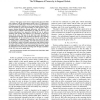Free Online Productivity Tools
i2Speak
i2Symbol
i2OCR
iTex2Img
iWeb2Print
iWeb2Shot
i2Type
iPdf2Split
iPdf2Merge
i2Bopomofo
i2Arabic
i2Style
i2Image
i2PDF
iLatex2Rtf
Sci2ools
HRI
2010
ACM
2010
ACM
Robots asking for directions: the willingness of passers-by to support robots
—This paper reports about a human-robot interaction field trial conducted with the autonomous mobile robot ACE (Autonomous City Explorer) in a public place, where the ACE robot needs the support of human passers-by to find its way to a target location. Since the robot does not possess any prior map knowledge or GPS support, it has to acquire missing information through interaction with humans. The robot thus has to initiate communication by asking for the way, and retrieves information from passers-by showing the way by gestures (pointing) and marking goal positions on a still image on the touch screen of the robot. The aims of the field trial where threefold: (1) Investigating the aptitude of the navigation architecture, (2) Evaluating the intuitiveness of the interaction concept for the passers-by, (3) Assessing people’s willingness to support the ACE robot in its task, i.e. assessing the social acceptability. The field trial demonstrates that the architecture enables success...
| Added | 25 Jan 2011 |
| Updated | 25 Jan 2011 |
| Type | Journal |
| Year | 2010 |
| Where | HRI |
| Authors | Astrid Weiss, Judith Igelsböck, Manfred Tscheligi, Andrea Maria Bauer, Kolja Kühnlenz, Dirk Wollherr, Martin Buss |
Comments (0)

